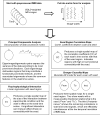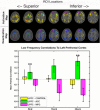Assessing functional connectivity in the human brain by fMRI
- PMID: 17499467
- PMCID: PMC2169499
- DOI: 10.1016/j.mri.2007.03.007
Assessing functional connectivity in the human brain by fMRI
Abstract
Functional magnetic resonance imaging (fMRI) is widely used to detect and delineate regions of the brain that change their level of activation in response to specific stimuli and tasks. Simple activation maps depict only the average level of engagement of different regions within distributed systems. FMRI potentially can reveal additional information about the degree to which components of large-scale neural systems are functionally coupled together to achieve specific tasks. In order to better understand how brain regions contribute to functionally connected circuits, it is necessary to record activation maps either as a function of different conditions, at different times or in different subjects. Data obtained under different conditions may then be analyzed by a variety of techniques to infer correlations and couplings between nodes in networks. Several multivariate statistical methods have been adapted and applied to analyze variations within such data. An approach of particular interest that is suited to studies of connectivity within single subjects makes use of acquisitions of runs of MRI images obtained while the brain is in a so-called steady state, either at rest (i.e., without any specific stimulus or task) or in a condition of continuous activation. Interregional correlations between fluctuations of MRI signal potentially reveal functional connectivity. Recent studies have established that interregional correlations between different components of circuits in each of the visual, language, motor and working memory systems can be detected in the resting state. Correlations at baseline are changed during the performance of a continuous task. In this review, various methods available for assessing connectivity are described and evaluated.
Figures



Comment in
-
Comment on "Assessing functional connectivity in the human brain by fMRI".Magn Reson Imaging. 2008 Jan;26(1):146. doi: 10.1016/j.mri.2007.06.002. Epub 2007 Jul 24. Magn Reson Imaging. 2008. PMID: 17651935 No abstract available.
References
-
- Horwitz B. The elusive concept of brain connectivity. Neuroimage. 2003;19(2 Pt 1):466–70. - PubMed
-
- Goebel R, Roebroeck A, Kim DS, Formisano E. Investigating directed cortical interactions in time-resolved fMRI data using vector autoregressive modeling and Granger causality mapping. Magn Reson Imaging. 2003;21(10):1251–61. - PubMed
-
- Friston KJ, Buechel C, Fink GR, Morris J, Rolls E, Dolan RJ. Psychophysiological and modulatory interactions in neuroimaging. Neuroimage. 1997;6(3):218–29. - PubMed
-
- Gonzalez-Lima F, McIntosh AR. Structural equation modeling and its application to network analysis in functinoal brain imaging. Human Brain Mapping. 1994;2:2–22.
Publication types
MeSH terms
Grants and funding
LinkOut - more resources
Full Text Sources
Other Literature Sources
Medical

